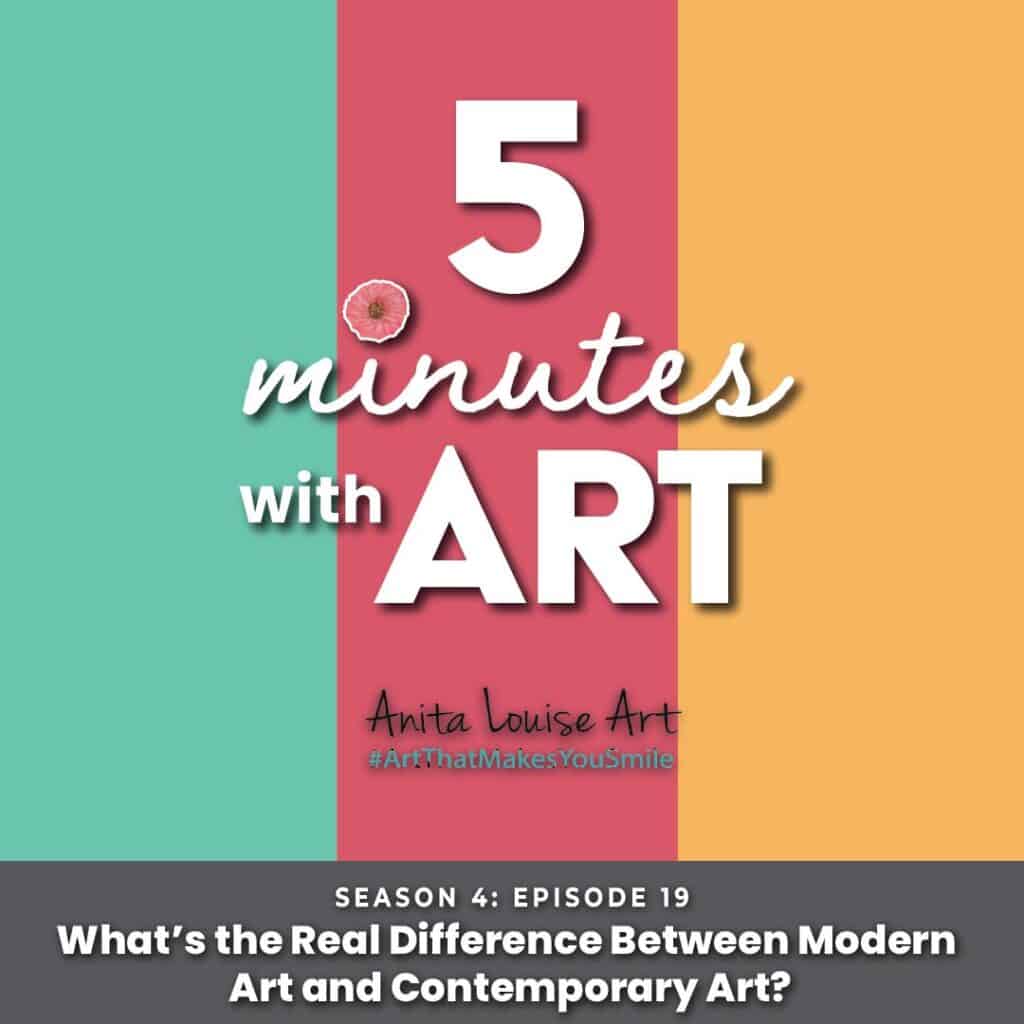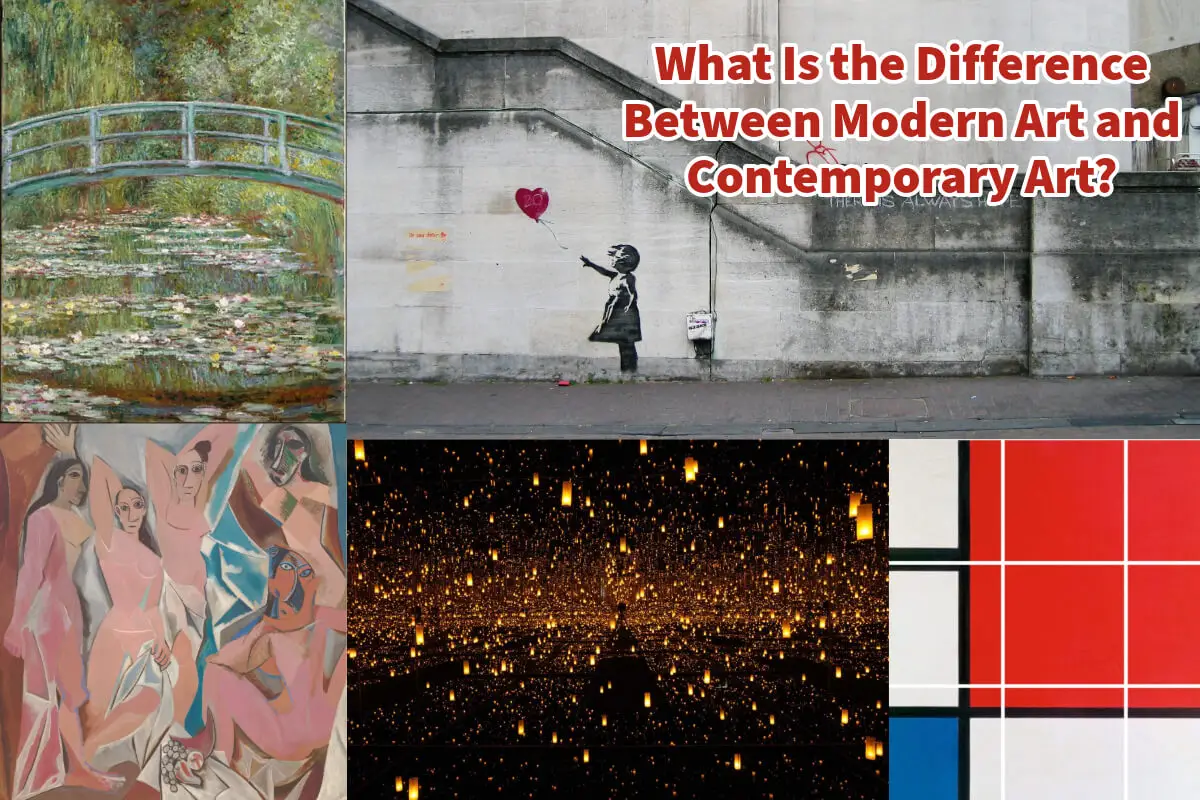Modern art. Contemporary art. You’ve heard both terms. Maybe even used them interchangeably. But they’re not the same. Mixing them up is one of the most common art-world mistakes. Let’s clear that up.
Whether you’re a student, a collector, or someone trying to sound smarter at a gallery opening—understanding the difference matters.
Table of Contents
- The Quick Answer: What Is the Difference Between Modern Art and Contemporary Art?
- Why Do People Get Confused Between Modern Art and Contemporary Art?
- The Big Differences Between Modern Art and Contemporary Art Summed Up
- Easy Ways to Tell Modern Art and Contemporary Art Apart
- FAQs About Modern vs. Contemporary Art
- Final Thought: Art Isn’t Just for Experts
- Related Questions
The Quick Answer: What Is the Difference Between Modern Art and Contemporary Art?
- Modern Art refers to art made roughly from the 1860s to the 1970s. Think Picasso, Matisse, and Mondrian.
- Contemporary art is art made from the 1970s to the present. Think Banksy, Ai Weiwei, and Yayoi Kusama.
It’s not just about when the art was made but also about how it thinks. Modern art was about breaking with tradition. Contemporary art is about questioning everything—even art itself.
Why Do People Get Confused Between Modern Art and Contemporary Art?
Let’s face it: the word “modern” sounds like it means “new.” So it makes sense that people assume modern art means current art. But in art history, “Modern” refers to a specific era.
In architecture, we had “Modernist” buildings in the mid-20th century—but we don’t call glass skyscrapers built in 2023 “modernist.”
It’s the same deal with art.
A Timeline Helps Clear Up Confusion
Here’s a rough breakdown:
| Art Type | Time Period | Famous Artists | Common Themes |
|---|---|---|---|
| Modern Art | 1860s – 1970s | Picasso, Matisse, Kandinsky, Mondrian | Abstraction, experimentation, innovation |
| Contemporary Art | 1970s – today | Banksy, Cindy Sherman, Hirst, Kusama | Identity, politics, technology, critique |
Modern Art: Break from Tradition
Modern art came during a time of rapid industrial change. Artists reacted to a world where trains moved faster than horses, and photography started challenging painting. So, they reinvented how art could look and what it could mean.
Key Movements in Modern Art:
- Impressionism – Light and brushstrokes (Monet)
- Cubism – Geometric forms (Picasso, Braque)
- Futurism – Speed and motion (Boccioni)
- Abstract Expressionism – Emotions through color (Pollock)
Visual Example:
- Claude Monet’s Water Lilies — blurred, light-soaked scenes

- Pablo Picasso’s Les Demoiselles d’Avignon — angular, abstracted faces

Modern art wasn’t just about beauty. It was about rebellion, innovation, and pushing limits.
Contemporary Art: Art That Talks Back
After the 1970s, the art world shifted. Artists started using new media: video, performance, installations. The focus moved toward concepts, identity, politics, and questioning what art even is.
Contemporary artists don’t just want you to look at something. They want you to think, feel, argue, laugh—or even feel uncomfortable.
Key Features of Contemporary Art:
- Concept-driven
- Multidisciplinary (video, sound, installations)
- Social commentary
- Personal identity and activism
Visual Example:
- Banksy’s Girl with a Balloon — political street art with emotion

- Yayoi Kusama’s Infinity Rooms — immersive spaces with mirrors and lights

This art talks to you. Sometimes even argues with you.
The Big Differences Between Modern Art and Contemporary Art Summed Up
| Feature | Modern Art | Contemporary Art |
|---|---|---|
| Time Period | 1860s–1970s | 1970s–present |
| Main Goal | Innovation in style and form | Critique of society, politics, self |
| Materials Used | Paint, sculpture | Video, digital, performance, mixed media |
| Famous Artists | Van Gogh, Picasso, Mondrian | Ai Weiwei, Banksy, Kusama |
| Common Movements | Cubism, Surrealism, Abstract Expressionism | Postmodernism, Conceptual Art, Street Art |
| Viewer Experience | Aesthetic appreciation | Interactive, emotional, political |
Easy Ways to Tell Modern Art and Contemporary Art Apart
- Look at the date – Before 1970? Likely modern. After? Likely contemporary.
- Is it trying to look different or say something different?
- Is it traditional (paint/sculpture) or using unexpected materials?
- Does it feel like it belongs in a history book or in a headline today?
Visual Comparison
Imagine two pieces of art:
Modern Art Example:
- Composition with Red, Blue, and Yellow (1930) by Piet Mondrian.

- Clean lines, blocks of color, no subject matter—focused on form.
Contemporary Art Example:
- Untitled (Portrait of Ross in L.A.) (1991) by Felix Gonzalez-Torres.

- 175 pounds of candy that viewers can take. It’s about love, illness, and loss (his partner died of AIDS).
One plays with shapes. The other is with your emotions and participation.
Why Knowing the Difference Matters
- If you’re collecting or investing in art, mislabeling can impact value.
- In school or galleries, it helps you understand the context.
- It sharpens your critical thinking. Modern art was about looking. Contemporary art is about thinking.
FAQs About Modern vs. Contemporary Art
Is modern art the same as contemporary art?
No. Modern art came first (1860s–1970s); contemporary art is from the 1970s to today.
Can an artist be both modern and contemporary?
No. Artists belong to one based on their era, though modern ones can inspire contemporary artists.
Is abstract art modern or contemporary?
Abstract art started in the modern period but continues in contemporary forms.
Why is contemporary art sometimes hard to understand?
Because it often focuses on concepts, not aesthetics. It invites interpretation and sometimes controversy.
Can photography be considered modern art?
Yes. Especially early 20th-century experimental photography.
Is street art contemporary?
Yes. Street art is a major part of contemporary practice.
Is pop art modern or contemporary?
Pop Art is considered late modern or early postmodern, bridging both eras. Think 1950s–1970s.
Final Thought: Art Isn’t Just for Experts
Understanding the difference between modern and contemporary art isn’t about gatekeeping. It’s about giving yourself tools to see more clearly, think more critically, and enjoy art more fully.
When you next walk into a museum or scroll past an artwork online, you’ll know: Is this breaking with the past? Or is it challenging the present?
Now, you’re not just looking at art. You’re reading it.
Want to go deeper? Check out these artists:
- Modern: Kazimir Malevich, Georgia O’Keeffe, Paul Klee
- Contemporary: Jenny Holzer, Kehinde Wiley, Tracey Emin
Listen To Our Podcast About What’s the Real Difference Between Modern Art and Contemporary Art?
Below or By clicking here.

Anita Louise Art is dedicated to art education, great artists, and inspiring others to find and create their art. We love art that uplifts and inspires. #ArtToMakeYouSmile! #ArtToMakeYouHappy!
If you are interested in seeing any of my art, you can find out more by clicking here. If you are interested in what inspires me and my paintings, you can discover more by clicking here.
We have a free newsletter and would love you to be part of our community; you can subscribe to the newsletter by clicking here. I would be happy to talk to you if you have any questions. You can reach me, Anita, by clicking here.
Subscribe to our Anita Louise Art YouTube Channel filled with great videos and information by clicking here.
Join us for our podcast “5 Minutes With Art.” Spend 5 minutes a week with us to discover and learn about great art and artists. You can find out more about our podcast by clicking here.
Related Questions
How Do I Make Money From My Abstract Art?
To sell your abstract art is the same as selling any other art. It will take a lot of time and effort. To sell the art, you must first have the product or the artwork, and then you must work on finding a way to promote your art. There are many ways that you can promote to sell your art.
By clicking here, you can learn more by reading the How Do I Make Money From My Abstract Art?
Pros and Cons Of Selling Your Artwork To An Art Gallery
When selling your art to an art gallery, you need to consider many pros and cons. One of the major pros is that the gallery usually helps you to market your artwork. A major con is that you usually lose control over who buys your artwork. An artist needs to weigh out if selling through an art gallery is what they want to consider to sell their artwork.
By clicking here, you can learn more by reading the Pros and Cons Of Selling Your Artwork To An Art Gallery.
Meaning Of “Art Speaks Where Words Are Unable To Explain”
A saying says, ” Art speaks where words are unable to explain.” In other words, Art can visually communicate things that the spoken or written word cannot.
“Art speaks where words are unable to explain” means that words, even though very powerful and profound, are not always able to convey the message as art can convey. Words are powerful, but an image or piece of art can be much more potent than the spoken or written word.
By clicking here, you can learn more by reading the Meaning Of “Art Speaks Where Words Are Unable To Explain”.

